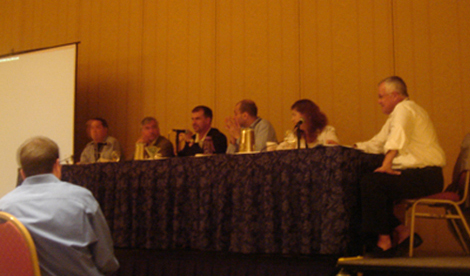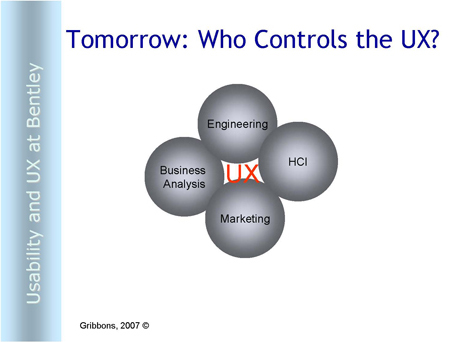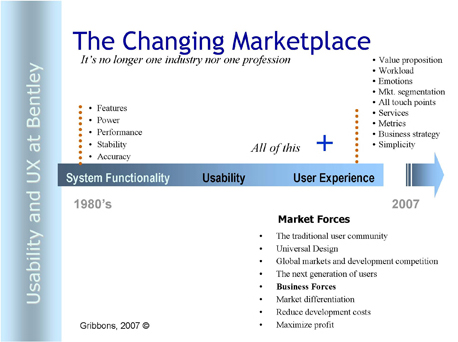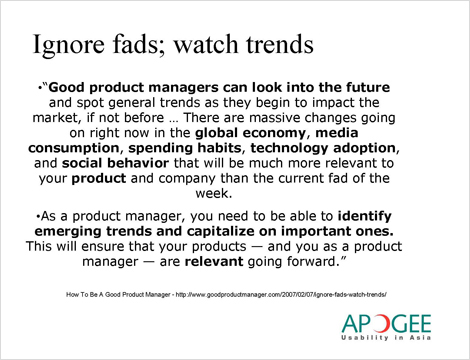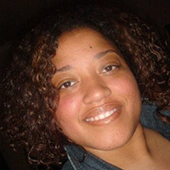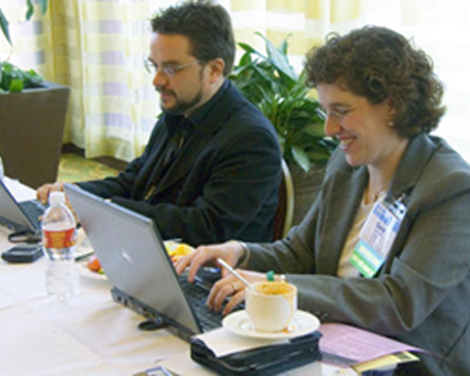
Even on the heels of the 25th anniversary SIGCHI conference, which attracted a large number of North American UX professionals, this year’s UPA conference reached a record high of 741 attendees. This makes an exciting statement about the growth that has taken place in our field and industry’s increasing recognition of usability professionals as strategic business partners in the product and service development lifecycles. Also, a conference focusing on patterns that garners this much interest seems to indicate that we are maturing as practitioners. This renewed interest shows we are seeking to learn from our successes, leverage our mistakes, and develop more efficient means of performing our work, with the hope that patterns will help.
I attended UPA 2007 with the hope of learning more about the relationship between design and patterns. Unfortunately, the designer’s perspective was not well represented at this conference. Given the history of the organization and its focus on usability testing, this was really no surprise, but one hoped for the best. The CHI 2007 conference had the same problem this year. If two of the largest and longest-standing UX conferences are not meeting the needs of designers, is it time for the design community to organize a new conference for themselves?
Despite this gap in the conference’s content, I learned something of even greater importance during the UPA conference this year. UX practitioners within every niche of the field are beginning to re-evaluate the working relationships within UX teams—between team members with different specialties—as well as with our external work partners—the members of multidisciplinary product teams. The next one or two years are going to be critical to the field of usability, as we attempt to redefine our roles and establish common definitions and processes in the face of increasing diversification. Creating awareness and beginning the dialogue solves half the problem. Because of the conversations and formal sessions that took place during the conference, what I took away from UPA 2007 was a sense of hope and anticipation for the future.
Organization
Overall, the conference was fairly well organized. The registration process was smooth and simple. Within seconds of mentioning your name, the registration booth staff provided a tote bag, water bottle, and a personalized packet, containing a welcome letter and registration receipt, the conference program, a conference badge, proceedings CD, and meal/drink tickets, plus information regarding any pre-registered workshops and tutorials. The registration booth (shown in Figure 2) and nearby message board served as the central information hub for the conference, providing a convenient place for attendees to learn about conference happenings, receive personal messages, and learn of any session additions or changes.

Overall, the conference planning committee, the hospitality booth staff, and the crew of poncho-clad conference volunteers (shown in Figure 3) made sure everything went on without a hitch. Having served in some of these roles in former years, I know they worked very hard during the conference and remain the unsung heroes. As an attendee with no conference-related obligations this year, I can say that everything looked great from the outside looking in.
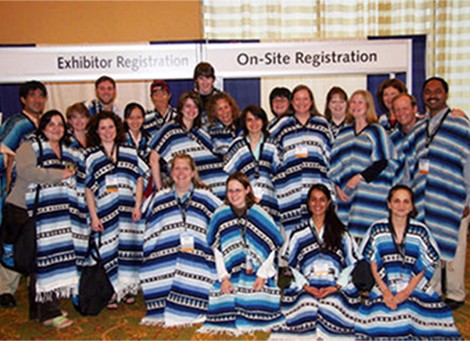
Content & Presenters
The first two days of the conference, Monday and Tuesday, were devoted to special sessions like tutorials, interactive workshops, and on Tuesday, the Experienced Practitioner program. Because of other commitments, I was unable to attend any of those sessions. On Wednesday, the conference officially began with an opening plenary. The three days of the conference were filled with sessions belonging to the following categories:
- invited speakers
- experienced practitioners
- methods and skills
- strategy and organization
- accessibility and internationalization
- consulting and testing
- design—Web, product, mobile, multimodal
- workshop highlights
As is traditionally the case with UPA, the conference served the usability testing community and Web-focused practitioners quite well. But, in response to our expanding global economy, this year’s conference also brought renewed focus on international issues, including recruiting international users, testing in newly tapped markets, and working in geographically distributed teams. In addition, I saw an improvement in the conference offerings for more experienced practitioners. Sessions extended beyond the discussion of advanced methodologies and cursory examination of usability institutionalization to slightly meatier issues regarding pricing models, metrics, and driving deep organizational change.
Finding this type of depth and variety in the session options was wonderful. But I was a bit surprised to discover that only a small percentage of the sessions were actually dedicated to the topic of patterns. Unlike at last year’s conference, where the organizers wove the Storytelling theme throughout every aspect of the event—from the host city, keynote addresses, conference sessions, and entertainment—this conference’s exploration of patterns seemed to be confined to just a few invited speakers and presentation sessions. Given the large body of research in the use of patterns for engineering, software development. and UX design, I expected there would have been more sessions relating to this topic. I am not sure whether this reflects a limited number of submissions on the topic or is an indication that the research in this field does not yet map well to practice. In any case, it would have been nice to see more on this topic during the conference.
As is often the case at conferences, there was too much to see and too little time. Since I couldn’t clone myself several times to cover all the sessions, I decided to focus my attention during the conference and, subsequently, I’ve focused my reviews on the more inspirational and business-relevant topics. At times, when more than one session during the same time slot piqued my interest, I bounced around a bit to capture as much knowledge as possible or swapped notes with someone who attended a different session. Here is a summary of what I learned, with the addition of some session notes I received from my colleague, Michelle Scavella.
Monday: Tutorial: Listening and Telling: The Practice of Storytelling in Modern Times
Facilitators: Kevin Brooks and Laura Packer
Since I’d been unable to attend the tutorials and workshops, when I arrived on site Tuesday afternoon, I talked to several presenters, facilitators, and participants about them. They praised one particular session highly: Kevin Brooks and Laura Packer’s tutorial “Listening and Telling: The Practice of Storytelling in Modern Times.” So I did a little research into what took place during their tutorial. Kevin Brooks and Laura Packer are two very interesting facilitators. Kevin is a storyteller and researcher at Motorola, with a background in communications, computer science, and film production as well as a Ph.D. in Media Arts and Sciences. He was the closing keynote speaker at UPA 2006. Laura—also a storyteller—has an amazing talent for spoken-word performance. She’d provided the entertainment at last year’s gala event at UPA.
Using their experience crafting and sharing stories, they facilitated an interactive tutorial that conveyed the power of storytelling and “storylistening” in human relationships—both in one’s personal life and in the workplace. “While the session was technically called a tutorial,” Kevin explained, “we designed it as a long workshop where the participants actually worked! So, much of the session had to do with the dynamics of their working together in different partnerships.”
As usability professionals, stories are inherent in all that we do. We observe, document, and share users’ stories; we design and deliver product stories. Learning about the nature of stories, their role in human life, and how to leverage stories in our communication styles is, therefore, invaluable knowledge to have. However, “many people mistakenly believe that storytelling is an activity for someone else—children, academics, or professional artists—but not for themselves,” said Kevin. Thus, at the start of the session, Kevin and Laura established that the act of sharing and receiving stories is inherent to all humans—to convey knowledge, serve as a tool of persuasion, offer entertainment, and help build individual and community relationships. Good listening, in turn, empowers the speaker, educates the audience, and enables us to understand one another better, thereby deepening our relationships.
Throughout the morning, Kevin and Laura led participants through a series of activities to familiarize themselves with the skills of telling stories, listening, and giving appreciation for storytelling. Some of the pointers they provided for giving appreciation for stories include the following:
- Determine and honestly express what was good or what you liked about what the speaker said.
- Be specific about what you heard.
- Identify what affected you positively.
- Identify how what the speaker said affected you.
- Since, in our society, we often don’t receive the appreciation we need and deserve, a speaker might behave strangely when receiving appreciation—through laughter, denial, deflection, or other inappropriate emotional responses. All of this is normal and often a natural part of the process.
- Remember, listening is just one among many tools. Your internal critic, good sense, experience, and professional knowledge are all good tools. Appreciative listening complements these other tools.
Kevin explained, “Because we live in a competitive culture, especially in industry, helping attendees become comfortable with these activities was critical. In typical business settings, unfortunately, most of what you do is interrupt or try to one-up one another.” Accordingly, many of the morning exercises taught participants to “shut up, relax, and realize you don’t have to contribute to the conversation. You’re in a privileged position of just being there.” Kevin admits that some people might think “it sounds a little Zen,” but this approach laid a good foundation for the second half of the day. In the afternoon, attendees built upon their earlier experiential knowledge and examined the more technical aspects of storytelling, including how to identify and create structures, patterns, motifs, and contexts for stories. By the end of the day, participants had gained a much deeper understanding of the relationships between story, the storyteller, and the listener, and more importantly, they learned how to apply this knowledge in their daily lives.
Resources
For more information about storytelling, Kevin and Laura recommend the following resources:
Birch, Carol L., and Melissa A. Heckler, eds. Who Says? Essays on Pivotal Issues in Contemporary Storytelling. Little Rock, AR: August House, 1996.
Bradbury, Ray. Zen in the Art of Writing: Essays On Creativity. Santa Barbara: Joshua Odell Editions, Capra Press, 1989.
Brooks, Kevin. Story—Storytelling—Business—Research.![]() Retrieved July 30, 2007. A nice collection of links to storytelling and business references.
Retrieved July 30, 2007. A nice collection of links to storytelling and business references.
Campbell, Joseph. The Hero with a Thousand Faces. New York: Pantheon Books, 1949.
Goldberg, Natalie. Writing Down the Bones. Boston: Shambhala, 1986.
LaMott, Ann. Bird by Bird. New York: Doubleday Books, 1994.
Lipman, Doug. Improving Your Storytelling: Beyond the Basics for All Who Tell Stories in Work or Play. Little Rock, AR: August House, 1999.
— The Storytelling Coach: How to Listen, Praise, and Bring Out People’s Best. Little Rock, AR: August House, 1995.
Livo, Norma J., and Sandra A. Rietz. Storytelling: Process & Practice. Littleton, CO: Libraries Unlimited, Inc., 1986.
Maguire, Jack. The Power of Personal Storytelling. New York: Tarcher, 1998.
Mellon, Nancy. Storytelling & the Art of Imagination. Shaftesbury, UK: Element Books, 1992.
National Storytelling Network. Storytelling in Organizations.![]() Retrieved July 30, 2007.
Retrieved July 30, 2007.
Pearson, Carol S. The Hero Within: Six Archetypes We Live By, 2nd Ed. New York: HarperCollins Publishers, 1989.
Simmons, Annette. The Story Factor: Inspiration, Influence, and Persuasion Through the Art of Storytelling. Cambridge, MA: Perseus Publishing, 2001.
Vogler, Christopher. The Writer’s Journey: Mythic Structure for Storytellers & Screenwriters. Studio City, CA: Michael Wiese Productions, 1992.
Wednesday: Opening Plenary Session & Keynote Address: A Sketch of Usability in the Broader Content of Design
Presenter: Bill Buxton
The opening plenary session began with a welcome from the conference chairs and members of the UPA board and planning committee. With this being the most highly attended UPA conference in at least five years, there was a bit of excitement in the air during the opening plenary. The UPA granted several awards during this plenary session. The UPA Usability Service Award went to Natalia Minibayeva and Dave Mitropoulos-Rundus, the Michigan Chapter received the UPA Chapters Award, and Whitney Quesenbery received the Presidents Award.
After the awards presentation, Bill Buxton, from Microsoft Research, gave the opening keynote. When Bill began his talk, which was entitled “A Sketch of Usability in the Broader Context of Design,” he stated that he would not answer the question “What is design?” because it is “one of those black holes that suck the life out of you” kinds of conversations. Instead, he examined the role of sketching in design. While Bill acknowledged that “sketching is not design,” he admitted that he’s “never seen design where there is not sketching.”
Sketching is the mechanism by which you, as the designer, work through the design process. It is also the means through which you communicate design ideas to others. For instance, if Bill asked you to draw your phone, everyone would know how to do that—even with limited drawing skills. But then, if he said, “Draw your phone’s interface,” the page would remain blank. Finally, if he asked you to draw the experience of using the phone, you could easily begin to express and articulate the concept visually. Reflecting on the notebooks of Mariano Taccola![]() , an artist and engineer during the Italian Renaissance, we can understand that “sketching came about when science and technology became too complex to work it out in your own head.”
, an artist and engineer during the Italian Renaissance, we can understand that “sketching came about when science and technology became too complex to work it out in your own head.”
Within the industrial design discipline, there is a strong sense of what is the appropriate style of representation at each phase of the design process. If you present something that is visually complete to your coworkers, they will believe you’ve finished your design process, and your design is ready for implementation. The visual language suggests a finality that is not real. So, to avoid sending the wrong message, designers intentionally leave holes and ambiguities in a design’s visual representation. As Figure 4 shows, Bill shared example sketches from Michael Sagan![]() —Trek Bicycles lead designer on Lance Armstrong’s racing bikes—showing how his visual representations evolved as the design progressed.
—Trek Bicycles lead designer on Lance Armstrong’s racing bikes—showing how his visual representations evolved as the design progressed.
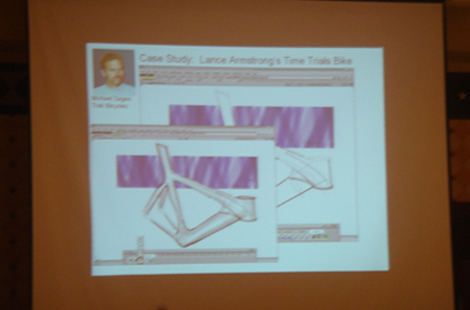
“In industrial design, there’s a strong sense of what is the appropriate style of representation. In our field, we don’t have this sense,” said Bill. To describe user experiences, we often use state-transition diagrams. However, in such representations, “all the resolution is in the states and not in the transitions.” Yet, in reality, the character, emotion, and feel of a user experience are about how you got there.
In the design field right now, we are transitioning from a materialist perspective on design to an experiential one. Bill stated this more strongly in what he calls his personal mantra, “Ultimately, we are deluding ourselves if we think that the products that we design are the things that we sell, rather than the individual, social, and cultural experiences that they engender, and the value and impact that they have. Design that ignores this is not worthy of the name.” Clearly, the need to understand how to better articulate experiences is great. One of Bill’s goals during this keynote address was to offer a meta-description of traditional sketches that we, as usability professionals, could apply to sketches of user experiences.
Some of the traditional qualities of sketches include the following:
- quick and timely
- inexpensive and disposable
- plentiful
- clear vocabulary—You know it’s a sketch.
- distinct gesture
- minimal detail—No higher resolution than that required to communicate the intended purpose.
- appropriate degree of refinement
- suggest and explore rather than confirm
- ambiguous
Sketching in user interface design is analogous to traditional sketching and, therefore, shares some of the same qualities. However, such sketches must also capture transitions, dynamics, feel, and phrasing. Sketches are not prototypes. Although both are instantiations of a design concept, they serve different purposes. The relationships between the two are as follows:
| Sketch | Prototype | |
|---|---|---|
Evocative |
|
Didactic |
Suggest |
|
Describe |
Explore |
|
Refine |
Question |
|
Answer |
Propose |
|
Test |
Provoke |
|
Resolve |
Tentative |
|
Specific |
Noncommittal |
|
Depiction |
During his presentation, Bill offered a few other important ideas for us to consider:
- With the status quo, usability testing generally occurs after the ideation and exploration phases. Typically, at this point in the process, a team can test only one design, so we end up focusing on getting the “design right” instead of getting the “right design.”
- Bringing usability activities earlier in the process lets you have a greater impact on the quality of the design at multiple stages along the way.
- Sketching is not only a tool for designers. It can be useful for test subjects as well. You can ask subjects to sketch their ideal solution. When sketching, users—who are typically overly positive in their feedback—open up and provide more critical feedback, as well as offering insights into their needs and preferences that did not come out during discussions.
- Treat ideas like commodities. As soon as you think ideas are precious, you start protecting them and stop producing new ones. If you come in with an idea that’s your baby, when someone critiques it, you’ll feel like it’s a personal attack. But if you always produce multiple design alternatives, you’ll develop the ability to learn from your mistakes and move on to generating new ideas. When there are multiple alternatives available, you have two opportunities for creativity: in the design options themselves and in the heuristics you use to choose the final solution. Also, when there are multiple design options, users feel more comfortable critiquing the designs.
Resources
For more information about sketching and prototyping, Bill recommends the following:
Buxton, Bill. Sketching User Experiences: Getting the Design Right and the Right Design. San Francisco, CA: Morgan Kaufmann, 2007.
Ericson, Eric, Johan Pihl, and Carl Reese. Design for Impact: Fifty Years of Airline Safety Cards. New York: Princeton Architectural Press, 2003.
Laseau, Paul. Graphic Thinking for Architects and Designers. Indianapolis, IN: Wiley Publishing, 1980.
Muller, Michael L. “Pictive: An Exploration in Participatory Design,” in Proceedings of the SIGCHI Conference on Human Factors in Computing Systems: Reaching Through Technology. Paper presented at CHI 1991, New Orleans, LA, USA, April 27–May 2, 1991. New York: ACM Press, 1991.
Pugh, Stuart. Total Design: Integrated Methods for Successful Product Engineering. Boston, MA: Addison-Wesley, 1990.
Rettig, Marc. “Prototyping for Tiny Fingers.” Communications of the ACM, Vol. 37, Issue 4 (April 1994).
Snyder, Carolyn. Paper Prototyping. San Francisco, CA: Morgan Kaufmann, 2003.
